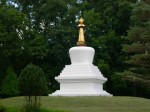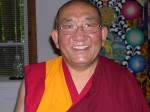By Suzette Martinez Standring, Past President, NSNC
 Only through the NSNC would I find myself in the bedroom of the Dalai Lama. Ducking into his second floor bedroom came toward the end of an afternoon’s visit by NSNC conference attendees to The Tibetan Mongolian Buddhist Cultural Center in southern Indiana. I’m here to report that His Holiness’ wooden daybed, covered in a yellow silk sheet, is not sized to stretching out comfortably. (Maybe he sleeps sitting up in the lotus position.)
Only through the NSNC would I find myself in the bedroom of the Dalai Lama. Ducking into his second floor bedroom came toward the end of an afternoon’s visit by NSNC conference attendees to The Tibetan Mongolian Buddhist Cultural Center in southern Indiana. I’m here to report that His Holiness’ wooden daybed, covered in a yellow silk sheet, is not sized to stretching out comfortably. (Maybe he sleeps sitting up in the lotus position.)
On a gold orange cushion set between two pillows the Dalai Lama smiles from a framed photo. Within easy reach from the bed is a three-tiered metal tray full of Tootsie Rolls. On daffodil-colored walls hang framed pictures of Tibetan scenes – mountain cliffs, Lake Mansarovar, a close-up of “mani” rocks (symbolically inscribed pebbles). Potala Palace in Llasa is prominently displayed, the place where the Dalai Lama was brought up. Does it conjure up childhood memories for him at night? Just outside of his bedroom was a furnished sitting room for meetings. The Dalai Lama has stayed at the TMBCC six times, most recently in May.
 I was at the TMBCC with the NSNC for a cultural afternoon of Tibetan song, food and Buddhist serenity, but most importantly, to meet Arjia Rinpoche. In Tibetan tradition, he is recognized as the incarnation of the Tenth Panchem Lama who is considered the second ranking figure in Tibet after the Dalai Lama. “Rinpoche” is a title given to a reincarnated being of a previous holy person.
I was at the TMBCC with the NSNC for a cultural afternoon of Tibetan song, food and Buddhist serenity, but most importantly, to meet Arjia Rinpoche. In Tibetan tradition, he is recognized as the incarnation of the Tenth Panchem Lama who is considered the second ranking figure in Tibet after the Dalai Lama. “Rinpoche” is a title given to a reincarnated being of a previous holy person.
 Appointed by the Dalai Lama, Arjia Rinpoche became the center’s leader in 2006, after the death of Thubten Jigme Norbu (Takster Rinpoche), the eldest brother of the Dalai Lama who founded TMBCC in 1979. Welcoming us to the Cultural Building, Arjia Rinpoche draped white “khatas” (scarves) around the necks of conference co-chairs Mike and Mardi Leonard, a Tibetan gesture of honor. Against a backdrop of colorful butter sculptures and exotic thangkas (Tibetan paintings) he spoke on Buddhist basics and shared bits of his life story, which are detailed in his book, Surviving the Dragon: A Tibetan Lama¹s Account of 40 Years Under Chinese Rule.
Appointed by the Dalai Lama, Arjia Rinpoche became the center’s leader in 2006, after the death of Thubten Jigme Norbu (Takster Rinpoche), the eldest brother of the Dalai Lama who founded TMBCC in 1979. Welcoming us to the Cultural Building, Arjia Rinpoche draped white “khatas” (scarves) around the necks of conference co-chairs Mike and Mardi Leonard, a Tibetan gesture of honor. Against a backdrop of colorful butter sculptures and exotic thangkas (Tibetan paintings) he spoke on Buddhist basics and shared bits of his life story, which are detailed in his book, Surviving the Dragon: A Tibetan Lama¹s Account of 40 Years Under Chinese Rule.
We feasted on noodles with vegetables, two types of dumplings, chicken with peppers, shredded cabbage salad and lightly spiced rice. A Tibetan woman in traditional dress sang native songs, sweet and melodic. Afterwards, we toured the grounds, a 108-acre nature preserve that includes
two traditional chortens (spiritual structures), a teaching pavilion, four retreat cottages, two private residences and the Kumbum Chamtse Ling Monastery. Within this two-story building, we entered a shrine room where a large Buddha was flanked on either side by four statues of bodhisattvas
(enlightened beings).
Behind the shrine, the wall popped brightly with scores of what resembled gaily-colored gumballs appliquéd on fabric to give a slightly 3-D effect. Elsewhere two magnificent Tibetan thangkas were hand-beaded. An altar prominently displayed religious items, such as a Jewish Torah and an icon of Jesus Christ, to indicate a welcome and acceptance of other faiths. I sat on an orange cushion on the Berber carpet to savor the peace that was palpable in that room.
As we were leaving, someone whispered, “Want to see the Dalai Lama’s bedroom?” So I scooted upstairs for a quick look-see. Leave it to the NSNC for an insightful, off-the-beaten path experience.
Email Suzette Standring: suzmar@comcast.net or visit www.readsuzette.com <http://www.readsuzette.com> She is syndicated with GateHouse News Service and is the award-winning author of The Art of Column Writing: Insider Secrets from Art Buchwald, Dave Barry, Arianna Huffington, Pete Hamill and Other Great Columnists.

